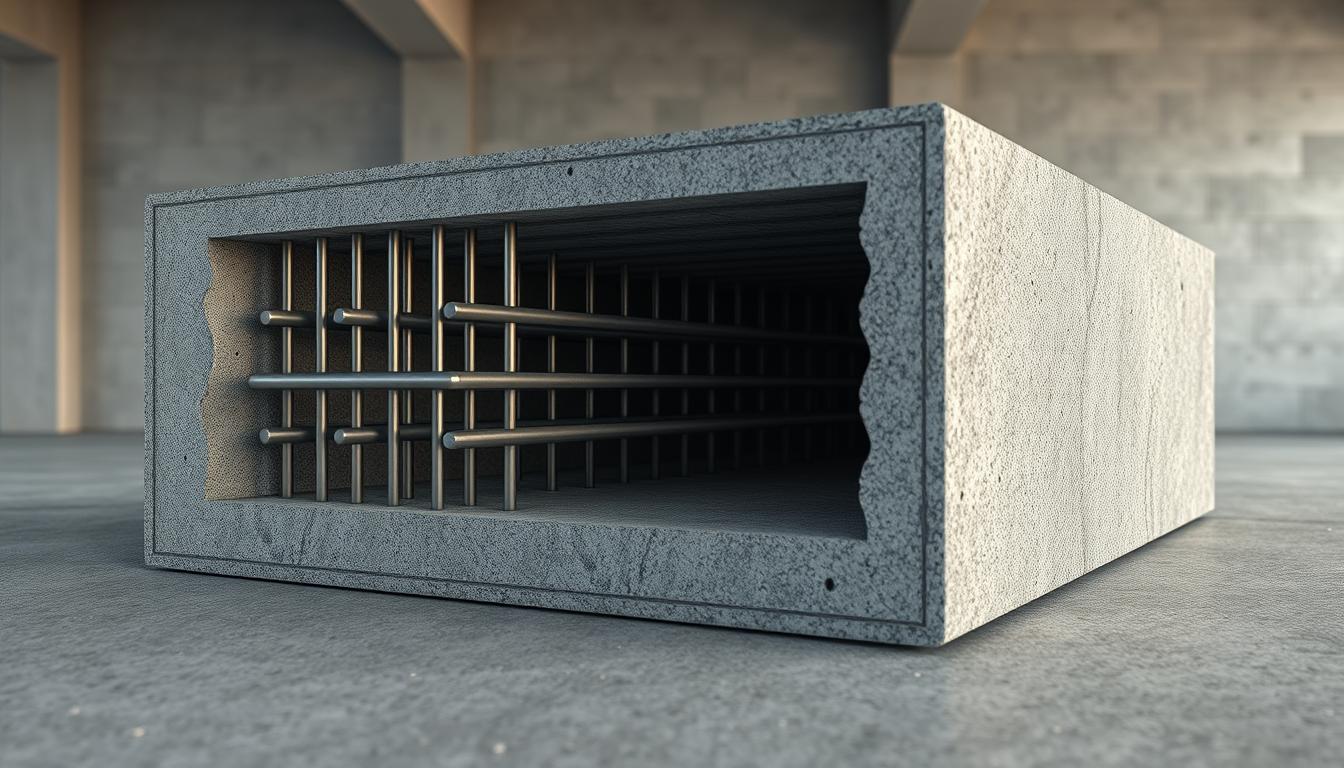The choice between structural steel and concrete for commercial buildings is a critical decision. It affects the project’s cost, timeline, and success. Each material has its advantages and disadvantages, requiring careful consideration of your project’s needs.
Steel has the highest strength-to-weight ratio, ideal for large, open spaces or heavy loads. It offers design flexibility, allowing for unique and custom designs. Steel is also 100% recyclable, making it eco-friendly for environmentally conscious builders.

Key Takeaways
- Steel offers the highest strength-to-weight ratio and greater design flexibility
- Steel is 100% recyclable and eco-friendly
- Concrete is less costly as a raw material but may require expensive machinery
- Concrete provides better fire resistance and insulation value
- Consider project-specific needs when choosing between steel and concrete
The decision between steel and concrete for your commercial structure depends on various factors. These include the building’s design, size, location, and intended use. By weighing the pros and cons of each material and considering your project’s specific needs, you can make an informed choice. This will ensure your commercial building’s long-term success.
Comparing the Cost of Steel and Concrete Construction
When it comes to commercial construction, the decision between steel and concrete hinges on cost considerations. Steel emerges as the more cost-effective option for commercial projects. This section delves into the financial disparities between steel and concrete building construction.
 Material Costs of Steel vs Concrete
Material Costs of Steel vs Concrete
Concrete’s components, including cement, sand, and gravel, are abundant and affordable, stabilizing its pricing. Steel, boasting the highest strength-to-weight ratio among building materials, enables the creation of robust structures with minimal material usage. This efficiency in material usage translates to cost savings. Advances in steel production have streamlined the process, allowing for the manufacture of one ton of steel in under one man-hour. This innovation has further diminished material costs.
Labor and Construction Costs
Labor expenses play a critical role in the total cost of a construction endeavor. Reinforced concrete necessitates the involvement of skilled contractors and experienced laborers, elevating costs. Concrete construction also involves waiting for forms to cure, extending the project timeline and increasing labor expenses. In contrast, the prefabrication of steel structures significantly reduces construction time. This reduction in time leads to lower labor costs, interim financing, and builder’s risk insurance expenses.
Long-Term Maintenance Costs
Long-term maintenance expenses are a critical factor in the overall cost of a construction project. Steel structures generally incur lower maintenance costs compared to concrete ones. Steel’s flexibility and malleability enable it to expand and contract without compromising its structural integrity, minimizing the need for frequent repairs. In contrast, concrete structures may necessitate more maintenance due to the curing process, which can result in cracks that are both structurally detrimental and aesthetically displeasing.
In conclusion, when evaluating steel and concrete for commercial construction, steel is significantly more economical. This is evident in material costs, labor and construction expenses, and long-term maintenance costs. Opting for steel components over concrete ingredients allows businesses to reduce expenses while ensuring a durable and enduring structure.
Durability and Strength: Steel vs Concrete
Steel and concrete each offer distinct benefits in terms of durability and strength. Steel, with its unmatched strength-to-weight ratio, surpasses concrete in this regard. Its superior tensile strength enables it to handle greater loads and stresses without failure.

Tensile Strength and Compressive Strength
Steel’s remarkable tensile strength allows it to endure significant stretching and bending forces without breaking. This characteristic makes it an ideal material for constructing tall structures, bridges, and frameworks that require high load-bearing capacity. In contrast, concrete’s poor tensile strength is offset by its superior compressive strength, making it well-suited for supporting heavy vertical loads.
Resistance to Natural Disasters and Extreme Weather
Steel and concrete each possess unique advantages when it comes to withstanding natural disasters and extreme weather. Steel’s flexibility and ductility enable it to better resist seismic activities and high winds. It can also be engineered to resist blast forces, ensuring the safety of blast-resistant buildings. For instance, RedGuard’s steel building withstood a blast test without sustaining structural damage, only shifting ¾ inch.
Concrete, though less flexible than steel, is inherently fire-resistant and can endure high temperatures without significant damage. It is also resistant to wind damage and pests, making it a durable option for long-term use. Yet, concrete’s brittle nature makes it more prone to cracking and fracturing under extreme stresses, such as those experienced during earthquakes or explosions.
Environmental Impact and Sustainability
Examining the environmental impact and sustainability of steel and concrete in commercial structures is critical. Factors such as recycling, carbon footprint, and urban heat island effect are key considerations. Steel stands out as 100% recyclable, being the most recycled material globally. In contrast, only about 50% of demolition concrete is recycled, underscoring steel’s superior recycling capabilities.
The steel industry has made significant strides in reducing its carbon footprint. Innovations in production have led to a 37% reduction in greenhouse emissions. On the other hand, the concrete industry’s environmental impact is substantial. Cement production, being the most energy-intensive of all manufacturing industries, requires temperatures of approximately 2,700 degrees Fahrenheit. This contributes to significant carbon dioxide emissions.
Recycling and Reuse of Steel and Concrete
Steel’s recyclability is a major advantage, as it can be repurposed indefinitely without losing its properties. In contrast, the types of concrete used in construction have limited recycling potentials. While some concrete can be crushed and reused as aggregate in new mixes, the process is not as efficient or widespread as steel recycling.
Carbon Footprint and Emissions
The cement industry is responsible for a significant portion of global carbon dioxide emissions. In contrast, the steel industry has made notable progress in reducing its carbon footprint. This is achieved through advanced production techniques and the use of recycled steel. As countries worldwide strive to reduce greenhouse gas emissions, the choice between steel and concrete becomes increasingly important.
Contribution to Urban Heat Island Effect
The urban heat island effect is another consideration when comparing steel and concrete. Light-colored concrete has the ability to reflect heat, which can help mitigate the impact of urban heat islands. Steel, on the other hand, does not have the same reflective properties. The use of cool roof coatings and green roofs can help offset this effect in steel structures.
“The steel industry’s commitment to sustainability and reducing its environmental impact is evident through its high recycling rates and continuous innovations in production processes.”
The choice between steel and concrete for commercial structures should consider their environmental impact and sustainability. While concrete doesn’t burn, the steel industry’s efforts to reduce emissions and maximize recycling make it an increasingly attractive option for environmentally conscious builders.
Steel vs Concrete: Design Flexibility and Aesthetics
The debate between steel and concrete in construction highlights their unique strengths and weaknesses. Steel stands out for its versatility and adaptability, often surpassing concrete in these aspects.
Steel’s ability to blend seamlessly into diverse designs is unparalleled. It can be prefabricated off-site and assembled swiftly on-site, cutting construction time by 30% to 50% compared to concrete. This method facilitates the creation of complex geometries and spans, ideal for landmarks like the Sydney Opera House and the Gateway Arch.
Concrete, while moldable into various shapes, demands more time and effort. It is favored for structures needing high stability, such as dams and high-rise towers. Despite this, concrete construction is often less expensive due to lower labor costs, thanks to its less specialized requirements compared to steel.
Steel’s superior strength allows for thinner columns and beams, maximizing open spaces and design flexibility. This makes it perfect for projects requiring expansive, column-free areas. In contrast, concrete’s robustness is ideal for environments needing substantial thermal mass or passive fire protection.
The choice between steel and concrete for commercial projects hinges on the project’s specific needs and aesthetic goals. Both materials can be tailored to meet sustainability standards like LEED certification, highlighting their environmental merits.
Steel vs Concrete: Safety Considerations
The choice between steel and concrete in commercial structures is critical for safety, impacting a building’s resilience against extreme events like explosions or earthquakes. Steel structures often outperform concrete in safety, being more effective in blast-resistant buildings.
Concrete’s brittle nature can be a safety risk in blast scenarios. Subjected to blast forces, concrete structures are prone to fracture, potentially producing dangerous fragments. These fragments can cause severe injuries to occupants. In contrast, steel’s high tensile strength and ductility enable it to absorb and dissipate blast energy more effectively. This minimizes structural damage and reduces harm risk to those inside.
Steel buildings, when designed correctly, can redirect blast energy away from interior spaces. This provides an additional layer of protection for occupants. Incorporating strategic structural elements like moment-resisting frames and shear walls enhances a steel structure’s blast resistance. Such design helps prevent collapse and reduces the risk of flying debris and other hazards.
While reinforced concrete boasts impressive compressive strength, its blast resistance is often limited by its brittleness. To improve concrete structure safety, additional reinforcement and thicker concrete walls may be required. These enhancements can increase construction costs and complexity. In comparison, steel’s inherent properties make it a more cost-effective and reliable choice for blast-resistant design.
Choosing Between Steel and Concrete for Your Commercial Project
When selecting materials for your commercial building, several factors are critical. The structure’s size, shape, and purpose, along with your project’s timeline, budget, and environmental goals, all play a role. These elements collectively determine the most suitable building material.
Steel is often preferred for its cost-effectiveness in structures with expansive bays or long spans. Its high strength-to-weight ratio makes it an ideal choice. Recent advancements in steel production have led to a 37% reduction in greenhouse gas emissions. The American steel industry boasts the lowest energy consumption per ton globally. Steel’s prefabrication also significantly reduces construction time, leading to substantial labor cost savings.
Reinforced concrete might be more economical for projects exceeding 50,000 square feet. It is composed of readily available materials like sand, gravel, water, and cement, with stable pricing over time. Yet, concrete construction necessitates skilled contractors and experienced laborers, potentially increasing labor costs and project timelines.
Hybrid structures, combining steel framing with concrete, such as tilt-up construction, are also worth considering. This method leverages the tensile strength of steel and the compressive strength and fire resistance of concrete. It offers a balanced approach to material selection.
In conclusion, the decision between steel and concrete for your commercial project hinges on a thorough analysis of your specific requirements. Seeking advice from seasoned professionals can guide you in making a well-informed choice. This choice should align with your priorities regarding cost, durability, sustainability, and design flexibility.
Conclusion
In the realm of commercial structures, the choice between steel and concrete hinges on several factors. Steel construction excels in strength, flexibility, and sustainability. In contrast, concrete offers lower raw material costs and superior corrosion resistance in marine environments. The decision between these materials is influenced by project-specific requirements, including budget, timeline, and environmental impact.
Steel buildings are generally lighter, with superior load-bearing and tensile strength. This makes steel ideal for high-rise and industrial projects. Steel’s pre-fabricated components also facilitate quicker assembly and lower labor costs. Yet, concrete’s resilience against fatigue and local availability can be advantageous in specific contexts.
From an environmental standpoint, steel’s 100% recyclability enhances sustainability. Concrete, while having lower emissions than steel production, is a significant factor in construction. Collaborating with experts who grasp the intricacies of steel vs concrete is essential. They can guide you in selecting the most suitable material for your project, considering design needs, market conditions, and maintenance requirements.
Ultimately, both steel and concrete hold value in contemporary commercial construction. A thorough evaluation of your project’s needs, coupled with the advice of seasoned professionals, will enable you to choose the optimal material. This ensures a balance between cost, performance, and sustainability for your commercial edifice.
FAQ
Which material is more cost-effective for commercial structures: steel or concrete?
The cost-effectiveness of steel versus concrete hinges on several variables. These include the building’s dimensions, design, and purpose. Concrete’s raw material cost is generally lower. Yet, steel’s superior strength enables the construction of robust structures with less material, potentially reducing overall expenses. The prefabrication of steel buildings also minimizes construction time and labor costs, contrasting with the labor-intensive process of reinforced concrete.
How do steel and concrete compare in terms of strength and durability?
Steel boasts the highest strength-to-weight ratio among construction materials, with unmatched tensile strength and shear resistance. In contrast, concrete exhibits considerable compressive strength but is brittle under tension, necessitating steel reinforcement. Steel’s flexibility and ductility make it a safer choice for blast-resistant structures. On the other hand, concrete structures are more vulnerable to damage from natural disasters and extreme weather conditions.
Which material is more environmentally friendly: concrete and steel?
Steel is 100% recyclable, making it the most recycled material worldwide. Approximately 50% of demolition concrete is recycled. Steel production innovations have decreased greenhouse gas emissions by 37%. Cement production for concrete, though, remains a significant source of carbon dioxide emissions. Light-colored concrete, by reflecting heat, aids in reducing urban heat island effects.
How do steel and concrete differ in terms of design flexibility?
Steel offers greater versatility and ductility than concrete, seamlessly integrating into diverse designs and supporting various loads. Steel structures can be prefabricated off-site, facilitating quicker construction and less waste compared to concrete, which must be cast on-site. Steel also necessitates less foundation work than concrete.
Which material is safer for commercial buildings: steel or concrete?
Steel’s tensile strength and ductility, combined with strategic design, render it the safest choice for blast-resistant structures. Properly designed steel buildings can effectively transfer blast energy away from interior spaces, minimizing damage and risk to occupants. Concrete’s brittle nature poses a safety risk in blast-resistant buildings, as fragments from fractured concrete can cause severe injury.
What factors should be considered when choosing between steel and concrete for a commercial project?
When deciding between steel and concrete, consider the building’s size, shape, and intended use, along with project timeline, budget, and sustainability goals. Steel is often more cost-effective for structures with wide bays or long spans. Concrete might be more economical for projects exceeding 50,000 square feet. Hybrid structures, combining steel framing with concrete, such as in tilt-up construction, are also worth considering.




